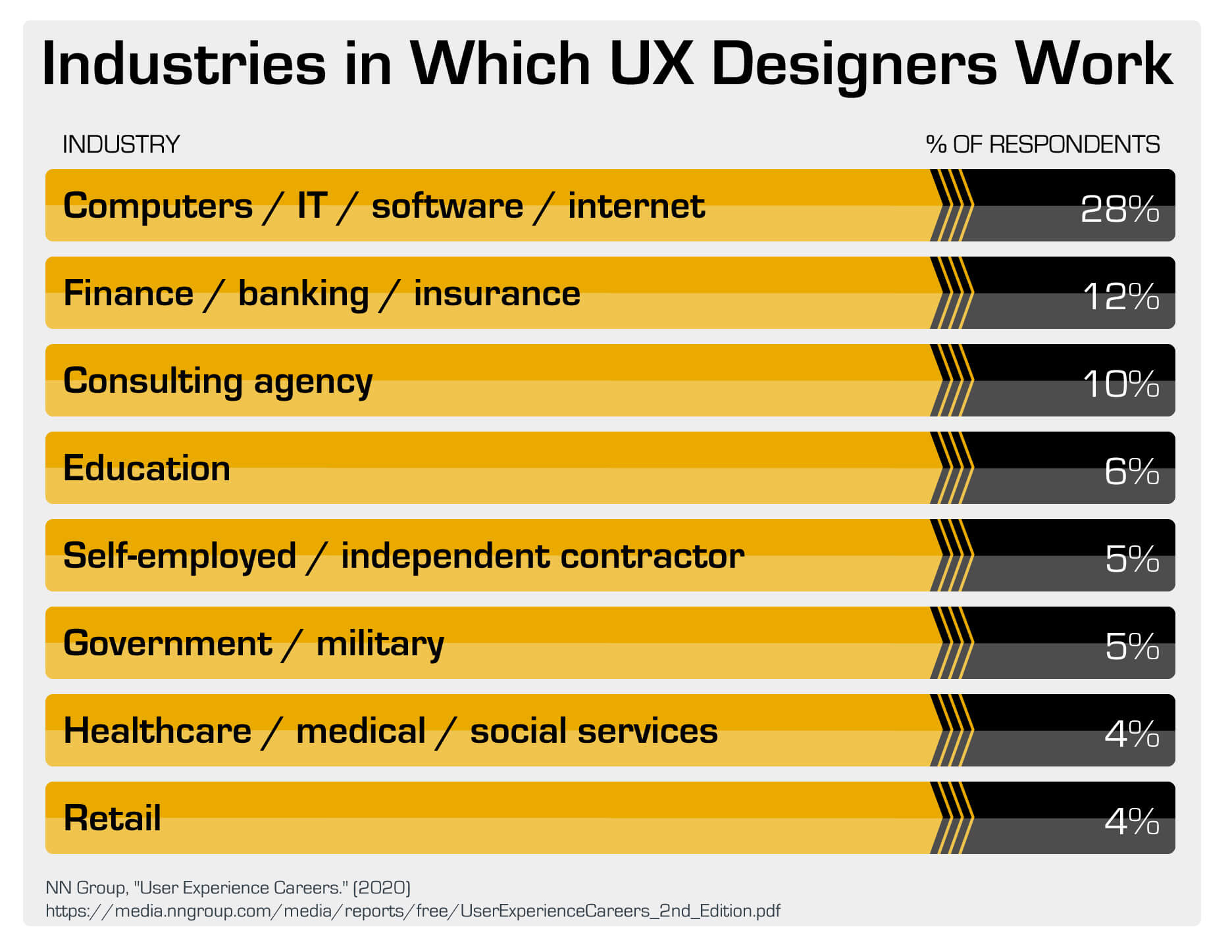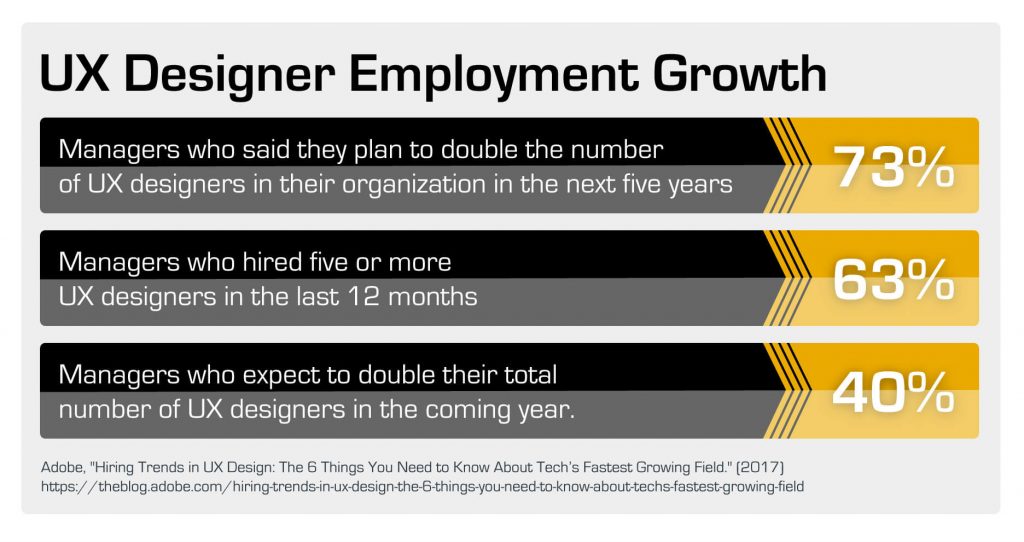11 Must-Have UX Designer Skills

A handheld video game console. A foldable camping fork. An online banking app. What do these all have in common? Though they’re as different as can be, they all share one key commonality: a UX designer’s expertise.
The job of a user experience (UX) designer is to create enjoyable and meaningful product experiences. These professionals conduct product research and investigate a target audience’s needs to guide the development of each product to be a natural fit.
Seem interesting? If you want to start your own career in the field, you’ll first need to develop a core set of UX design skills — both hard and soft — to help you chart your path as a UX designer and create seamless product experiences.
For a practical example, let’s return to that online banking app we mentioned earlier. When you tap the app’s icon, you find a simple, pleasant-looking log-in screen. You sign in, and immediately see your accounts organized in an easy-to-follow list. Navigating the app is easy; the process so intuitive that the idea of critiquing it never even comes to mind. The experience is exactly what you need it to be — simple, quick, and convenient.
All of those factors — from color palette to interface design to navigation — are crucial to ensuring the success of a product. Any UX professional worth their salt needs to learn how to accomplish each of these things, and more, to execute on these goals
While tech industries are most closely affiliated with UX, virtually every modern industry requires UX to craft products that touch lives. According to a recent report published by NNGroup, the top sectors for UX design in 2019 included computers and IT, finance, consulting, education, government, healthcare and social services, retail, media and publishing, marketing, telecommunication, business, entertainment, aerospace and automotive, and nonprofit.

Interested in delving into the industry, but don’t know which UX design skills you’ll need to kickstart your career? Don’t worry; in this article, we’ll dive into the hard and soft skills that form the bedrock of the profession.
Hard Skills for UX Designers
Design Thinking
Design thinking is a UX design skill that lies at the heart of the profession. The process it outlines is simple: UX professionals identify a problem, map out potential fixes, iterate those possible solutions through prototyping, test and refine those preliminary products, and finally deploy a finalized solution. This cycle can be repeated an infinite number of times throughout the lifetime of a service or product.
Design thinking is crucial to the role because it empowers designers to respond to users’ changing environments and behaviors. As the world grows increasingly complex and tech-forward, it falls on designers to proactively brainstorm and implement innovative solutions to unexpected problems — preferably before consumers encounter them.
For more insight, check out this list of additional resources:
- The Explainer: What is Design Thinking? — Harvard Business Review
- Designing for Growth Field Book: A Step-by-Step Project Guide — Jeanne Liedtka
- The Design Better Podcast — Design Better
Decision Mapping
Like design thinking, decision mapping provides a high-level theoretical overview of how to approach and solve problems. However, decision mapping is explicitly tied to resolving research problems, creating clarity on why research is being conducted, and syncing findings with strategic decision-making.
Decision mapping commonly begins with a simple question, such as:
- Should we build this product?
- Can we remove this feature without any negative consequences?
- What is the best way to design the product site’s navigation?
After answering these queries, researchers then outline key hypotheses and assumptions that will underlie the decision-making process. Assumptions may be related to users, such as how much money they’re willing to spend, or tied to designer workflow or other production-side factors.
Afterward, researchers design a framework for how data will be collected and analyzed. The results are then used to answer the primary question and, ultimately, develop a better product.
Check out these resources below:
- A Guide to User Experience Mapping for UX Design — Adobe
- Customer Journey Mapping 101 — NNGroup
- Mapping Experiences: A Complete Guide to Creating Value through Journeys, Blueprints, and Diagrams — James Kalback
Prototyping
Prototyping offers a means for UX designers to grapple with a technical challenge. Professionals use the process to assess product performance, see how users might utilize it, and identify any user problems before the project goes into production. This allows designers to experiment with form and function without needing to continually rebuild fully-fledged products.
First, UX designers sketch out their ideas, either on paper or through simple software, which can then be improved upon through the input of other developers and teammates. The sketch serves as a basis for a low-fidelity wireframe, which maps out exactly how elements should be positioned without any emphasis on functionality.
Afterward, designers create an HTML-based or an interactive prototype that defines the product’s functionality. Developers and company stakeholders can use a prototype to get a full picture of how the product will look and function before it is officially hard-coded.
Designers use a few industry-wide tools to churn out prototypes quickly. Sketch, Adobe XD, Axure RP, and Balsamiq are a few of the most common, though they differ in their pricing, specific features, and convenience. For instance, Balsamiq is best for those that want to develop low-fidelity, non-interactive prototypes, while Axure RP allows for integrating animations and team collaboration.
For more information, take a look at these instructional guides:
- What is a Prototype? A Guide to Functional UX — UXPin
- Building to Learn: The Role of Prototyping in Design — UX Design
- Designing UX – Prototyping: Because Modern Design is Never Static — Ben Coleman and Dan Goodwin
Basic Front End Coding
If a website were an iceberg, the “front end” would be the tip — it defines everything that an end-user can directly see and interact with.
Generally speaking, the front end is comprised of three primary coding languages: HTML, CSS, and JavaScript.
HTML, or HyperText Markup Language, is a tag-based language that developers use to define a web page’s structure. With HTML, developers block out paragraphs, images, tables, and other media in a plain-text file with a “.html” extension.
Plain HTML elements are, quite frankly, ugly. CSS (Cascading Style Sheets) is used to style basic HTML through added spacing, colors, font types, sizing, and a limited set of behavioral changes.
JavaScript then takes this basic styling several steps further by making the website dynamic and highly responsive to user behavior. Developers use JavaScript to implement interactive animations and compute client-side logic.
Though front end programming knowledge isn’t a UX designer skill that is required for every position, it has become increasingly important to the field. Designers need to be able to communicate with developers through a shared understanding of what developers can reasonably do and what problems they may face during the development process.
If you’d like to learn more, take a look at these resources:
- HTML Crash Course for Absolute Beginners — Traversy Media
- How to Learn CSS — Smashing Magazine
- JavaScript Basics — Mozilla Developer Network
Soft Skills for UX Designers
UX isn’t all about analysis and technical know-how. You have to be able to speak confidently, listen, and present your insights at every step.
While the hard UX design skills serve as a prerequisite to landing the role, it’s your soft skills that ultimately make you a stand-out designer.
Empathy
You are designing products for real people who are impacted by the decisions you make and the service you’re delivering. Given this, you will need to curate a deep understanding of the audience you design for.
Ask yourself:
- Do I believe in the product?
- Would this product make the lives of end-users better?
- Am I committed to making this service as painless as possible to use and access?
These fundamental questions serve as a basis for empathy. Often confused with sympathy, empathy is more than just understanding the challenges that people face — it’s the ability to share the feelings of another person.
Empathy is a creative, dynamic response that requires you to set aside your perspective and beliefs to take on those of another. It is not enough for designers to rely on previous research or second-hand data to generalize about end-users; they need to put themselves in their ideal user’s shoes and consider that user’s environment, primary motivations, fears, and goals.
UX designers even respond to situation-specific challenges that arise within an industry. Just consider the impact of the COVID-19 crisis:
- For the first time in our lives, the world’s collective routines have been put on hold.
- Millions lost their jobs in a matter of months.
- Physical distancing has become the norm.
Experts believe that this “quarantine state of mind” will trail on long after quarantine measures are over. Now that simple handshakes are a faux pas, the coronavirus has pathologized intimacy as dangerous and shifted the way that consumers behave.
How have UX designers responded? They have made it easier for clients to access resources digitally and communicate from a distance. They have made masks a wardrobe icon and curated pathways for immunocompromised consumers to access essential services.
In short, every public-facing company has had to respond dynamically to the developing crisis; active empathy is an essential part of tailoring products and services to meet new consumer needs.
For more information, take a look at these additional resources:
- Sympathy vs. Empathy in UX — NNGroup
- How to Practice Empathy in Your UX Work — Echo & Co
- Practical Empathy: For Collaboration and Creativity in Your Work — Indi Young
Communication
Sure, every company includes “excellent communication skills” on their job postings. However, not every career requires as high a degree of communicative ability as UX design does.
In UX, communication is a crucial ingredient through which collaborative, fully-fledged products are conceptualized and released. UX communication takes place in three contexts: within the UX community, within the company, and with clients.
Communication is how designers advocate for a project with company stakeholders, develop solutions with teammates, and demonstrate the unique findings of their research. In a business context, UX designers shouldn’t shy away from expressing their needs or those of clients.
Communication has gained even more importance in recent months, as COVID-19 has sparked a growing trend toward remote working. According to recent research, 84 percent of businesses plan to increase remote work after COVID-19. Today, 4.7 million US workers are fully remote — and the trend seems unlikely to disappear with COVID-19.
Given this new emphasis on remote work, UX designers need to be more expressive than ever in their communications. You’ll need to take care to listen and respond as clearly as possible through online discussions.
On video calls, it’s naturally more difficult to express body language and active listening through our usual cues. With a slight audio lag, coworkers can seem less engaged or even passive-aggressive. Effective communication requires curating critical arguments in a forthright, understandable, and compelling way — so hone your (remote) conversational skills!
Check out these resources below:
- Why UX Professionals Must be Good Communicators — UX Mastery
- 11 Communication Techniques for Designers — UX Design
- Remote UX Work: Guidelines and Resources — NNGroup
Collaboration
Collaboration is another crucial UX designer skill. By working together, designers can more easily define a problem and consolidate their efforts to establish a workable solution.
Though it’s tempting to take on a project on your own, it’s often what’s worst for the end product. To borrow a quote from one UX Design researcher, “Many designers, trying to sustain that image [of being a design unicorn], keep pushing for a one-person show. Without the input of other team members, the final product often reflects the bias of a siloed, myopic worldview.”
In recognition of this truth, many companies have shifted away from the single-designer model and instead utilize entire teams to tackle usability problems. Development and design teams are more complex than ever, especially as they’ve been tasked with making products as successful as possible.
The best UX teams are defined by their diversity. Consider the words of Pluralsight VP Mariah Hay, who once stated: “Teams with women simply perform better … I’m no expert on this topic, but there’s lots of thought leadership out there on why this happens. From team psychology to empathetic decision making, gender diversity is a true competitive advantage.”
Small companies often start with a single-person design team that eventually grows as the business develops. Designers should welcome the opportunity to break out of their isolation and learn from those who have life and career experiences that are different from their own.
Want further insights? Explore these resources:
- How UX Professionals Collaborate on Deliverables — NNGroup
- Promoting Collaboration in UX, Design, and Content Teams — InVision
- Collaboration is King: How Teaching Your Teammates Will Boost Your Impact — Shopify
Flexibility
The design world isn’t immune to change. No matter how perfect your product might be, it will eventually need to evolve. After all, users’ wants, needs, and expectations shift dynamically with their environments. As a UX designer, you must be flexible and adaptable to client and company needs alike, as well as capable of identifying changing client needs and providing flexible, versatile solutions that suit their evolving desires.
In your work, you’ll need to implement context-dependent solutions to broader issues. Consider this example problem: Some clients want to browse a brand’s product catalog, while others want to buy directly. How can you bifurcate an e-commerce platform to provide browsing, yet not bog down those that know precisely what they need?
Flexibility requires responding to sets of problems that are often in direct conflict with each other. Develop clarity around the issue at hand, your key priorities, and the resources available to you — and then create an adaptable solution.
Check out these resources that touch on the importance of flexibility:
- The Importance of Planning a Flexible UX Design Process — Web3 Canvas
- What is Workplace Flexibility? — The Balance Careers
- The Future of Work is Creative, Flexible, and Human — Entrepreneur’s Handbook
Where to Learn These Skills
While we’ve linked to some excellent resources above, they will not teach you everything you’ll need to know to land your first entry-level UX design role. To do that, you will want to seek out additional formalized training.
Some find success scouring the web for virtual, self-directed online training. Online courses make it easy to achieve a low-cost education; however, keep in mind that you’ll need to dedicate time to developing a portfolio and making industry connections.
On the other hand, if you want a comprehensive education that covers the theory and practice of UX design, we recommend investing in a college program. UX designers hail from a wide variety of majors, including computer science, marketing, business, art, or design. College gives you the time and resources to land internships, build UX design skills, make connections, and curate a portfolio.
That said, college may not be for everyone. If you have a passion for UX design but can’t commit the time or resources to invest in a conventional university degree program, consider enrolling in a boot camp.
Many UX designers have found success with boot camps — intensive, short-term programs that equip learners with industry-grade UX designer skills in as little as three to six months.
Keep in mind that while boot camps are fantastic for teaching UX designer skills quickly, they don’t offer the same deep, theory-driven reservoir of knowledge that a college program does. Ultimately, your choice will depend on your interests, capabilities, and needs.
What Next?
To say that businesses are aware of UX’s importance would be an understatement.
According to Onward Search’s list of the “19 Most In-Demand Digital Creative Talent for 2019”, UX designers were the second-most in-demand professionals of the year.
Their popularity will likely persist, too; in 2017, researchers for Adobe found that 73 percent of surveyed managers said that they planned to double the number of UX designers in their organization within five years. Researchers for DICE Insights similarly anticipate that job growth for UI/UX professionals will rise 14.9 percent over the next decade — much faster than the growth projected for most other careers.

Opportunities clearly abound — and if you made it to the end of this article, chances are good that you’re genuinely interested in pursuing them. So start looking into your educational opportunities. Whether it’s college, a professional boot camp, or late-night YouTube tutorials, there are countless ways to equip yourself with most in-demand UX design skills.

 Live Chat
Live Chat